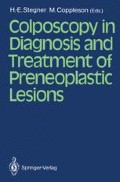Abstract
A number of social characteristics define the women at high risk for the development of cervical cancer or precancer. These include marital status, age at marriage, parity, and a number of sexual behavioral features such as an early age of first intercourse, an increased number of sexual partners, and an increased risk of developing sexually transmitted diseases. For completeness, reference is usually made to race and ethnicity as other contributing risk factors. However, in the last decade various sociologic and biologic changes have occurred within the female population at risk for cervical cancer and also within certain male groups so that now we have not only these highly relevant female factors but also some new factors which are starting to identify high-risk groups for cervical squamous carcinoma. Now we may finally include the male as well as his female counterpart in this high-risk grouping. There is evidence to suggest that there does exist a high-risk male whose female partners are at an increased risk of developing cervical neoplasia.
Access this chapter
Tax calculation will be finalised at checkout
Purchases are for personal use only
Preview
Unable to display preview. Download preview PDF.
References
Aurelian I, Manak M (1981) The herpes-virus hypothesis. Gynecol Oncol 12:56–87
Buckley JD, Harris RW, Doll R, Vessey MP, Williams PT (1981) A case controlled study of the husbands of women with dysplasia and carcinoma in situ. Lancet 2:1010–1015
Harris RW, Brinton RH, Cowdell R, Skegg D, Smith P, Doll R, Vessey MP (1980) Characteristics with dysplasia and carcinoma in situ of the uterine cervix. Br J Cancer 42:359–369
Martin CE (1967) Marital and coital factors in cervical cancer. Amer J Publ Health 57:803–814
Miller AB, Barclay TH, Choi MG (1980) A study of cancer, parity and age at first pregnancy. J Chronic Dis 33:595–605
Singer A, Reid BL, Coppleson M (1976) A hypothesis; the role of the high-risk male in the aetiology of cervix cancer. Amer J Obstet Gynecol 126:110–116
Trevathan E, Layde P, Webster L (1983) Cigarette smoking and dysplasia and carcinoma in situ of the uterine cervic. J Amer Med Ass 250:499–502
Waterhouse J, Muir C, Correa P, Powell J (1976) Cancer incidence in five continents, Vol III. International Agency for Research on Cancer
Editor information
Editors and Affiliations
Rights and permissions
Copyright information
© 1988 Springer-Verlag Berlin Heidelberg
About this chapter
Cite this chapter
Singer, A. (1988). High-Risk Groups for Cervical Cancer. In: Stegner, HE., Coppleson, M. (eds) Colposcopy in Diagnosis and Treatment of Preneoplastic Lesions. Springer, Berlin, Heidelberg. https://doi.org/10.1007/978-3-642-72761-0_2
Download citation
DOI: https://doi.org/10.1007/978-3-642-72761-0_2
Publisher Name: Springer, Berlin, Heidelberg
Print ISBN: 978-3-540-17947-4
Online ISBN: 978-3-642-72761-0
eBook Packages: Springer Book Archive

